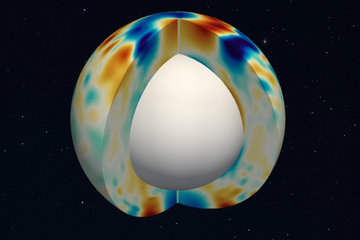All genres
21.
Journal Article
Solar Ultraviolet Bursts. Space Science Reviews 214, 120 (2018)
22.
Journal Article
Charge States and FIP Bias of the Solar Wind from Coronal Holes, Active Regions, and Quiet Sun. Astronomical Journal 836, 169 (2017)
23.
Journal Article
Magnetic topological analysis of coronal bright points. Astronomy and Astrophysics 606, A46 (2017)
24.
Journal Article
Explosive events in active region observed by IRIS and SST/CRISP. Monthly Notices of the Royal Astronomical Society 464 (2), pp. 1753 - 1761 (2017)
25.
Journal Article
The Plasma Parameters and Geometry of Cool and Warm Active Region Loops. Astrophysical Journal 842, 38 (2017)
26.
Journal Article
Narrow-Line-Width UV Bursts in the Transition Region above Sunspots Observed by IRIS. Astrophysical Journal 829, L30 (2016)
27.
Journal Article
Explosive Events Associated with a Surge. Astrophysical Journal 701, p. 253 (2009)
28.
Journal Article
Coronal hole boundary evolution at small scales. I. EIT 195 Å and TRACE 171 Å view. Astronomy and Astrophysics 503, pp. 991 - 997 (2009)
29.
Journal Article
EIS/ Hinode Observations of Doppler Flow Seen through the 40-Arcsec Wide-Slit. Solar Physics 252, pp. 283 - 292 (2008)
30.
Journal Article
Small-scale flows in SUMER and TRACE high-cadence co-observations. Astronomy and Astrophysics 482, pp. 273 - 278 (2008)
31.
Journal Article
The structure and dynamics of a bright point as seen with Hinode, SoHO and TRACE. Astronomy and Astrophysics 492, pp. 575 - 583 (2008)
32.
Journal Article
On the relation between DC current locations and an EUV bright point: A case study. ASTRONOMY & ASTROPHYSICS (1), pp. 345 - 352 (2008)
33.
Journal Article
Magnetic topology of blinkers. Astronomy and Astrophysics 488, pp. 323 - 329 (2008)
34.
Journal Article
Jets or high-velocity flows revealed in high-cadence spectrometer and imager co-observations? ASTROPHYSICAL JOURNAL (1), pp. L57 - L60 (2007)
35.
Journal Article
Line broadening of EUV lines across the solar limb: A spicule contribution? Astronomy and Astrophysics 431, pp. L17 - L20 (2005)
36.
Journal Article
Optical and EUV observations of solar flare kernels. Astronomy and Astrophysics 444, pp. 593 - 603 (2005)
37.
Journal Article
Electron density along a coronal loop observed with CDS/SOHO. Astronomy and Astrophysics 439, pp. 351 - 359 (2005)
38.
Journal Article
Transition region small-scale dynamics as seen by SUMER on SOHO. Astronomy and Astrophysics 427, pp. 1065 - 1074 (2004)
39.
Conference Paper
Computing the global coronal magnetic field during activity maximum and minimum with a newly developed nonlinear force-free Yin-Yang code. In: EGU General Assembly Conference Abstracts, pp. EGU - 17168. EGU General Assembly Conference Abstracts, Vienna, Austria, 2023. (2023)
40.
Conference Paper
Evolution of coronal hole boundaries seen in EIT 195 Å and TRACE 171 Å images. In: Modern Solar Facilities - Advanced Solar Science, pp. 249 - 252 (Eds. Kneer, F.; Puschmann, K. G.; Wittmann, A. D.). Universitätverlag Göttingen (2007)











